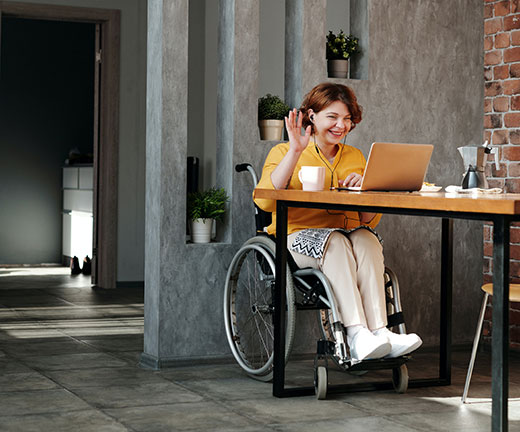
Technology and home modifications can help older adults age safely at home.
K-State expert shares tips for aging safely at home
Many home modifications are simple…and free
July 6, 2020
MANHATTAN, Kan. – A Kansas State University specialist in adult development and aging says technology and advance planning are on the side of older adults who want to spend their golden years in their own homes.
“Most older adults do want to age in place, or stay in their homes, and live independently as long as they can,” Erin Yelland said. “In order to do that, there are things we can do around the house to make it more comfortable and a safer place to live.”
Listen to an interview with Erin Yelland on the weekly program, Sound Living with Jeff Wichman
Many medical alert systems – which allow a person to call emergency help at the touch of a button -- cost less than $100 and can provide an important safeguard for those living alone. Yelland said some of the newer smart watches can even detect when a person falls.
“Smart devices can help adult children monitor their older adult parents in their homes,” she said, noting that technology is available that uses pressure sensors to detect if a person has opened a medicine cabinet or gotten out of bed in the morning.
And, she adds, “much of today’s smart-home technology is incredibly user-friendly,” allowing homeowners to turn on lights or make sure doors are locked with a press of a button. “Once those are set up, anyone can use it and these things will last for years.”
Yelland said there are many ways to modify a home – some at no-cost – to make living at home more likely for older adults.
“The first thing is to de-clutter,” Yelland said. “The less stuff you have, the less of a struggle you are going to have and the less you have to clean.”
Yelland suggests removing throw rugs or cords that stretch across a room, “anything that will pose a tripping hazard.”
For those with mobility issues, perhaps using a walker or wheelchair, Yelland advises keeping as much open wall space as possible, “to be able to walk up against the wall and balance yourself, if needed.”
“Some other things you can think about that are also free include lowering items in your kitchen cabinets, or anywhere in your house that you have to reach up or get on a step stool to retrieve items. It’s important to lower items to reduce the risk of someone losing their balance or having a fall.”
To prevent burns, Yelland said older adults should consider lowering their water heater temperature to 120 degrees Fahrenheit or lower. “A lot of older adults have a delayed reaction time to hotter temperatures, or don’t realize at first that the water is hot,” she said.
“There are a lot of different free things that we can do around the home. I encourage everyone to start walking around room to room and think about some of those things to make the home a safer place.”
Some other in-home changes can cost a little to a lot more money, she said.
Some of the lower-cost options include improving lighting by installing night lights in hallways and dark areas; installing handrails and grab bars; touchless faucets; and changing door handles from knobs to levers.
“A lot of older adults who have arthritis, for example, find it really difficult to grab a traditional rounded door knob,” Yelland said. “Levers make it easier to get in and out of rooms, as well as function around the house.”
Among higher cost improvements, Yelland said homeowners should think about widening doorways, installing an outdoor ramp and replacing flooring.
“Flooring can be really tricky in the home, especially in the bathroom,” she said. “If you have slippery flooring, you need to look into getting that replaced.”
Yelland said the Americans with Disabilities Act and the National Association of Homebuilders recommend a friction coefficient – a measure of friction on a floor’s surface – of .6 or higher to prevent slippery areas.
“If you don’t have the dollars to completely replace your flooring, you can buy some slip-resistant coating that you can paint on your floor with a roller brush; it costs about $85 per room to apply that slip-resistant coating,” Yelland.
To help prevent falls in the bathroom, Yelland suggests placing a non-slip mat in the shower, installing grab bars, using a shower chair, or installing a walk-in tub.
K-State Research and Extension has numerous programs and publications to help older adults age well, including ‘Simple Modifications for Aging in Place.’ More information on additional programs and publications is available online.

